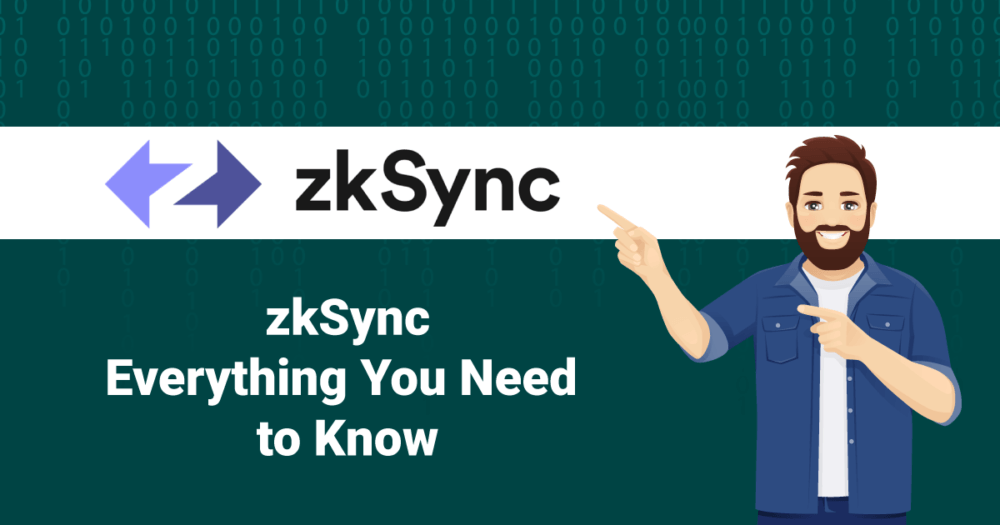Every blockchain network is limited by its throughput capacity. The question is how much data it can handle before it becomes overly congested. In the case of blockchains, network nodes fulfill the duty of verifying data integrity, which means they are prone to congestion.
This is where zkSync, a scalability solution, comes into the picture.
This blog will give you a detailed overview of zkSync, why it is needed, its history, how it works, its features and benefits, and its usage.
So, let’s get started.
What is zkSync?
- It is a Layer 2 blockchain protocol that eliminates Ethereum’s congestion with zero-knowledge proofs.
- This layer 2 solution helps in the transfer of Ether and ERC20 tokens.
- It acts as a scaling and privacy engine for Ethereum.
- For “unlimited” Ethereum scaling, zkSync is used.
- The project is built on a zero-knowledge (ZK) rollup architecture.
A Brief History of zkSync (zkSync 2.0)
- In the summer of 2020, the zkSync project began. However, the creator, Matter Labs, started working on Layer 2 scaling zero-knowledge proofs in 2019.
- When it launched in June 2020, it delivered 300 transactions per second in the first interaction.
- There were qualitatively different features in zkSync 2.0, like account abstraction and EVM support through Solidity and Vyper.
How does zkSync work?
First things first. Let us define a rollup
- Technical implementation of a layer 2 solution.
- Or in other words, it is also an Ethereum extension that has been designed to increase scalability.
- It is responsible for rolling up multiple transactions in a single batch and sending them together to Ethereum.
- They allow for low-cost verification because all the assets are locked in smart contracts on the layer 1 blockchain.
ZK rollups vs. Optimistic rollups
The only major difference between these two rollups is verification, also known as the method of finality.
ZK rollups
- These use zero-knowledge proofs to verify transactions and then roll them onto the Ethereum main chain.
- Their operator creates proof of validity for all the off-chain transactions with the help of SNARK, which stands for a succinct, non-interactive argument of knowledge.
Optimistic rollups
- These rollups apply a different approach to verification.
- Unlike the zkSync rollup, these do not prove the validity of every rollup.
- They assume that all the off-chain computation is valid unless proved otherwise.
- These rely on fraud proofs and not validity proofs.
- As the fraud proofs claim that the state of Ethereum is invalid, challenging Ethereum is a difficult process.
The transaction rates are higher and cheaper fees are cheaper in ZK rollups as compared to optimistic rollups.
Features of zkSync
Features
The most crucial features of ZK rollups are low gas transfers for ETH and ERC20 tokens. Together with it, the transfers are even faster and cheaper than L1 or optimistic rollups.
- The transfer fee is $0.02.
- The withdrawal fee is $1.59.
- The one-time activation fee is $0.44.
- Mint NFT is $0.05.
Advantages and disadvantages of zkSync
Benefits
- It also supports “gasless meta-transactions.” This is when users pay gas fees with transferred tokens.
- It also offers the advantage of smart contract interoperability. The developers can reuse Solidity code.
- It also has the support of atomic swaps and limit orders.
- It also supports native Layer 2 NFTs.
- It is open-source.
Disadvantages
- It is observed that users are withdrawing their funds back to the L1 protocol.
- Users have to wait for finalization in a single batch.
- Proving every batch in a zkSync dApp needs high computational power.
- This is why dApps are rare in ZK rollups.
How Can You Use zkSync?
This is how you can use zkSync.
Connect wallet
- The easiest and simplest way to use it is by connecting the zkSync wallet.
- Most clients support wallets like Torus, MetaMask, KeepKey, Ledger, Keystone, Trezor, Portis, Coinbase Wallet, etc.
- Connecting a layer 1 ETH wallet via Argent Wallet or Wallet Connect is also possible.
Make cheap and fast transfers
- It offers inexpensive crypto payments for over a million transfers.
- You can easily use zkSync to send transfers in EHT and ERC20 tokens.
- It also has a block explorer and analytics system known as zkScan, just like any other blockchain, such as Ethereum.
- Over 14 million transactions, in which over 135 thousand blocks have been verified,
The zkSync Ecosystem
The blockchain protocol is no less strong than its ecosystem. It is very well known that the ecosystem decides the quality and longevity of the project in Layer 2. There are so many things that now dominate this ecosystem. These include infrastructure projects, DeFi, NFTs, wallets, bridges, etc.
Interestingly, the zkSync ecosystem is a true paradise for Web3 developers and gamers.
Today, several big projects are onboard, the biggest of which is Argent, Reddio, OKX Wallet, Mute.io, 1Inch Network, Taker, Balancer, ZigZag, Onto Wallet, Curve, and Yearn.finance.
Conclusion:
ZkSync is indeed a prospective solution that can do wonders for Ethereum-based projects. The protocol can contribute immensely to enhancing the efficiency and speed of transactions without hampering security, boosting the evolution of the DeFi ecosystem.




